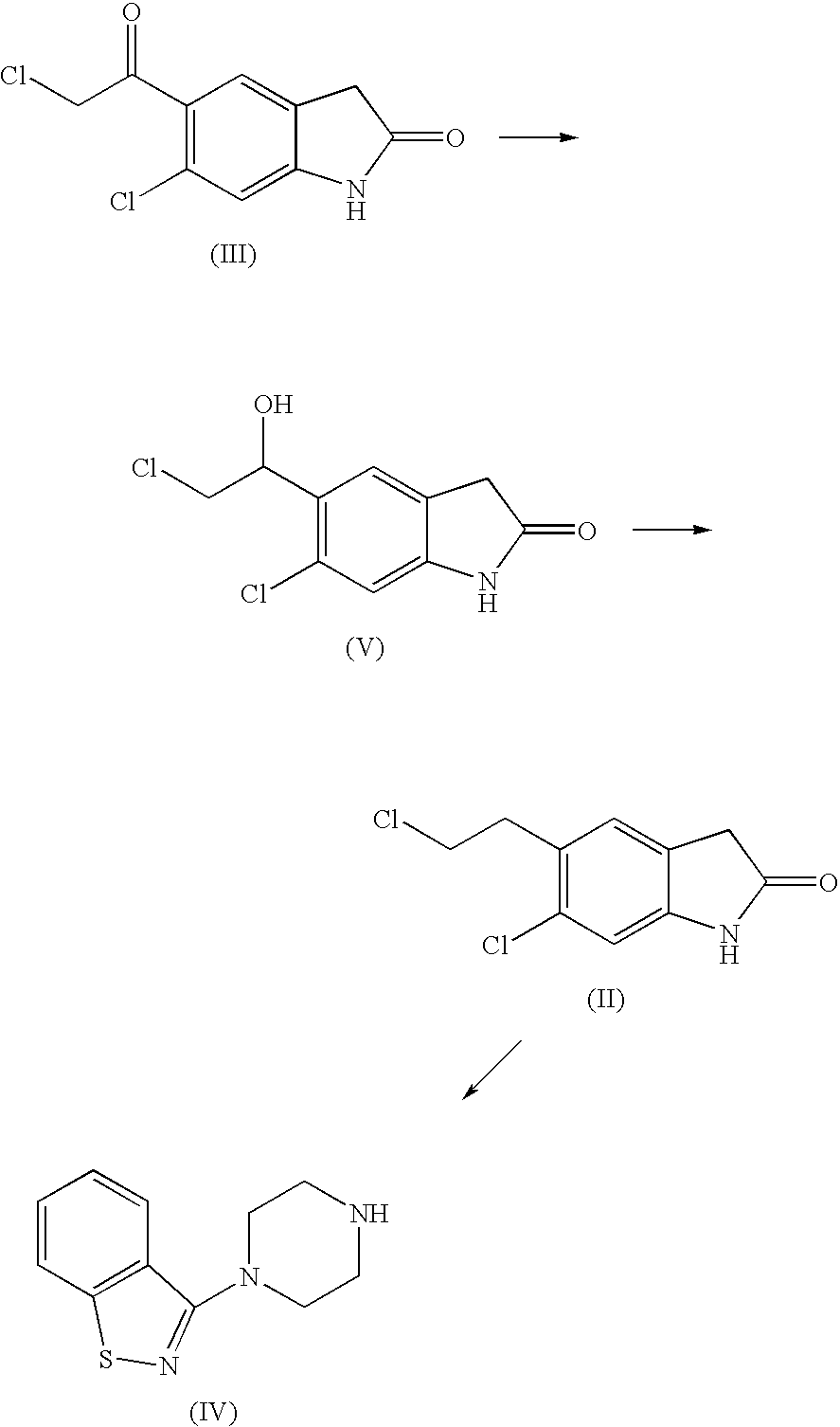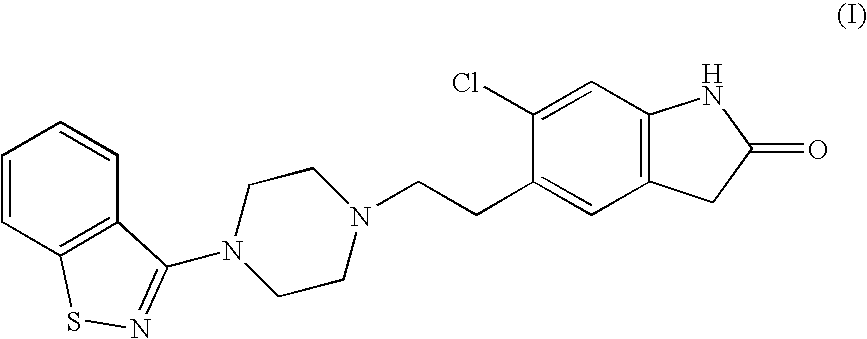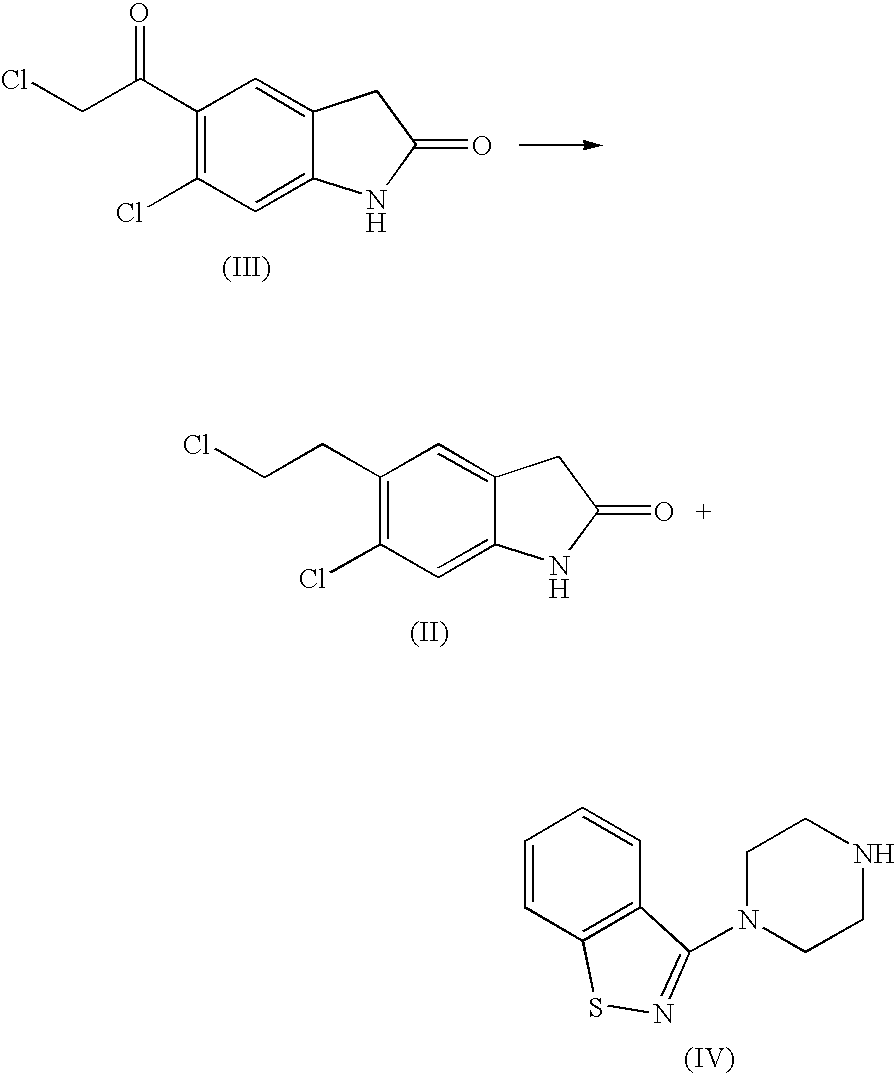Process for the preparation of ziprasidone
a technology of ziprasidone and ziprasidone, which is applied in the field of ziprasidone preparation process, can solve problems such as affecting product cos
- Summary
- Abstract
- Description
- Claims
- Application Information
AI Technical Summary
Benefits of technology
Problems solved by technology
Method used
Image
Examples
example 1
6-Chloro-5-(2-chloro-1-hydroxy-ethyl)-1,3-dihydro-indol-2-one. (V)
[0024] A reactor is loaded with 200 g (0.82 mol) of 6-chloro-5-(2-chloro-acetyl)-1,3-dihydro-indol-2-one, in 1L of ethanol. The reaction mixture is added with 15.5 g (0.41 mol) of sodium borohydride in portions, under strong stirring, at room temperature. The temperature is kept at 15-20° C. during the addition, after that the mixture is left under stirring for about 15 h at room temperature. The mixture is then added with 250 ml of glacial acetic acid and refluxed (approx. 85° C.) for 1 hr 30 min, then 200 ml of acetic acid are added and the mixture is refluxed a further 30 min, then cooled to 20° C. The suspension is filtered and washed with ethanol and heptane. The solid product is dried under vacuum at a temperature of 60° C., to obtain 177 g (88% molar yield).
Puriflcation of 6-Chloro-5-(2-chloro-1-hydroxy-ethyl)-1,3-dihydro-indol-2-one. (V)
[0025] A reactor is loaded with 25 g of 6-chloro-5-(2-chloro-1-hydroxy-...
example 2
6-Chloro-5-(2-chloro-ethyl)-1,3-dihydro-indol-2-one. (II)
[0029] A 2 L round-bottom flask is loaded with 300 g (1.22 mols) of 6-chloro-5-(2-chloro-1-hydroxy-ethyl)-1,3-dihydro-indol-2-one and 1140 ml of trifluoroacetic acid, under nitrogen atmosphere. The mixture is stirred at room temperature for 1 h, then heated to about 35-40° C. 214 ml (1.34 mols) of triethylsilane are then dropped therein in approx. 1 hr 30 min, keeping stirring for 12-14 h. Separately, a round-bottom flask is loaded with 3000 g of a water / ice mixture and the reaction mixture is carefully dropped therein, in about 1 hr 30 min, under strong stirring. The resulting white suspension is stirred for 30 min, then filtered, washed with purified water (4×500 ml) and heptane (400 ml), then dried at 60° C. under vacuum to afford 281 g of 6-chloro-5-(2-chloro-ethyl)- 1,3-dihydro-indol-2-one.
example 3
5-(2-(4-Benzo[d]isothiazol-3-yl)piperazin-1-yl)ethyl)-6-chloro-1,3-dihydro-2H-indol-2-one hydrochloride. (I)
[0030] A reactor is loaded with 131 g (0.57 mol) of 6-chloro-5-(2-chloro-ethyl)-1,3-dihydro-indol-2-one, 125 g (0.57 mol) of piperazinyl benzoisothiazole, 260 ml of dimethylsulfoxide, 26 ml of water and 4.3 g (0.0285 mols) of Nal. The reaction mixture is added with 103 g (0.969 mol) of Na2CO3, with stirring under nitrogen atmosphere. The resulting mixture is heated to about 115-125° C. in 1 h and kept at said temperature under stirring for approx. 1 hr 45 min, then cooled and slowly added in about 25 min with isopropyl alcohol (650 ml), at a temperature of about 110° C., then slowly cooled at 25° C. The filtrate and the precipitate are washed with isopropyl alcohol (2×130 ml) to obtain 310 g of 5-(2-(4-benzo[d]isothiazol-3-yl) piperazin- 1-yl)ethyl)-6-chloro- 1,3-dihydro-2H-indol-2-one free base, as a crystalline solid. The resulting product is placed in a 3 L beaker with 150...
PUM
| Property | Measurement | Unit |
|---|---|---|
| temperature | aaaaa | aaaaa |
| temperature | aaaaa | aaaaa |
| temperature | aaaaa | aaaaa |
Abstract
Description
Claims
Application Information
 Login to View More
Login to View More - R&D
- Intellectual Property
- Life Sciences
- Materials
- Tech Scout
- Unparalleled Data Quality
- Higher Quality Content
- 60% Fewer Hallucinations
Browse by: Latest US Patents, China's latest patents, Technical Efficacy Thesaurus, Application Domain, Technology Topic, Popular Technical Reports.
© 2025 PatSnap. All rights reserved.Legal|Privacy policy|Modern Slavery Act Transparency Statement|Sitemap|About US| Contact US: help@patsnap.com



